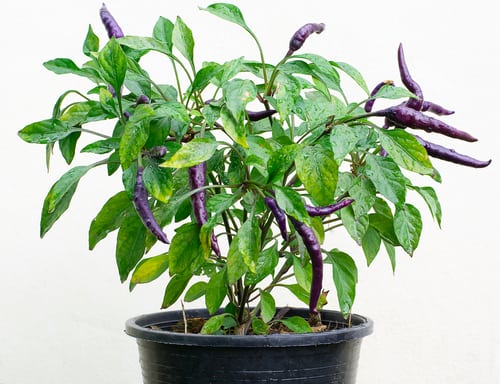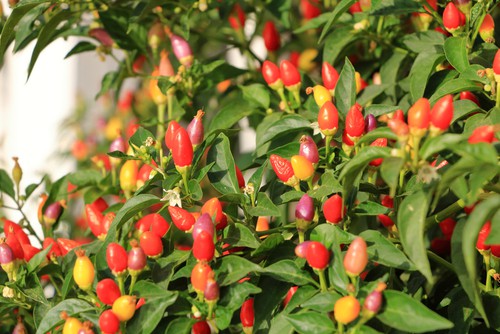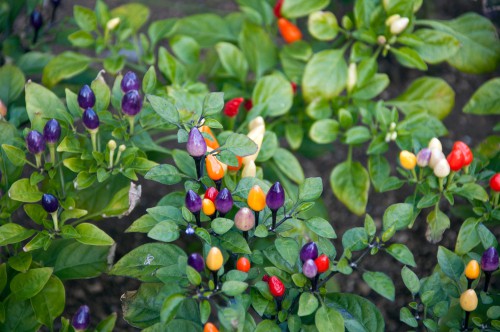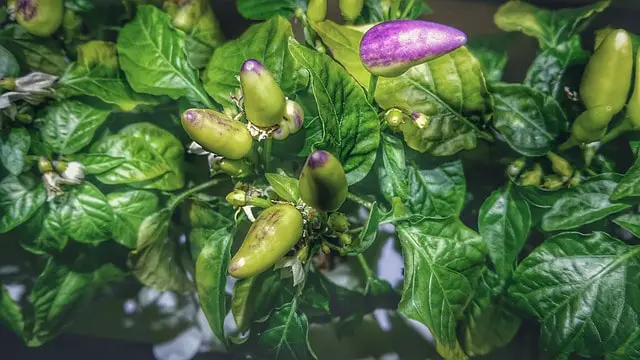Pepper plants are the perfect addition to add color to your landscape or garden and liven various dishes. In particular, purple super hot peppers are beautiful ornamental plants that lighten any indoor and outdoor space.
Their rich royal color and unique shapes will be a subject of conversation among friends, visitors and other plant enthusiasts. Add to it that when mature, fruits from these pepper plants are versatile, serving as a perfect addition to various dishes, including salads, sauces, pasta dishes etc. In addition, they are nutritious, excellent antioxidant sources with several health benefits.
So, if you consider adding purple super hot peppers into your plant collection, there is no reason to back out. However, you first must understand that there are several types of purple super hot peppers, each with distinctive features, care tips, and much more.
This post will cover the various types of purple super hot peppers, but first, let’s discover all there is about Purple peppers and how they can brighten your garden, spice up your food and optimize your gardening journey.
What are Purple Peppers?

Purple peppers are rising in popularity as ornamental plants. They are the edible fruits of various plants belonging to the species Capsicum annum, encompassing multiple shapes and sizes of peppers, including the famous sweet bell peppers.
Endemic to southern North America, the Caribbean and northern South America, purple peppers’ popularity continues to soar worldwide, and it’s not complex to understand why.
These plants can adapt to various growing conditions and require minimal care. You can grow purple peppers in your outdoor garden, greenhouse, and in small containers that you can place in a bright spot inside your home.
The general rule of thumb when planting peppers is to start them indoors not less than eight weeks before the last frost date for your location.
Also, avoid planting hot peppers too close to each other since they are self-pollinators. Instead, space crops 18 inches apart in rows. Most importantly, constantly harvest mature chillies to encourage your pepper plant to produce more flowers and fruits.
Note that there are three categories of purple peppers. Sweet purple peppers, as the name implies, are famous for their mild, sweet flavor and include the bell pepper. The other categories are hot purple peppers and ornamental peppers grown for decorative purposes.
This post will focus on the hot purple peppers, an ingredient in recipes and foods. They spice up dishes and can be included in salads, salsas and sauces.
Types of Purple Super Hot Peppers
There are a variety of purple peppers best suited for decorative and culinary purposes. Our list covers the top ten Purple beauties that are the perfect addition to any garden or home.
1. Purple Cayenne Peppers

Cayenne peppers are the most famous and hottest purple pepper plants. This plant is a colorful indoor addition that matures from green to purple to red. It has lustrous purple flowers and thin dark-violet chillies.
Although a relatively small plant that’s best grown in containers, the purple cayenne plant is an excellent yielding plant. This two-foot plant is covered with purple fruits, which begin as green peppers that turn purple and red in late maturity. The chillies are about 3 inches long and relatively thin.
It’s best to harvest the chillies in their dark-violet color and add them to soups, salads, and dishes for a spicy kick and delicious taste. Besides its use as a flavorful culinary regimen, purple cayenne pepper will be an attractive addition to your yard or garden.
Purple cayenne plants are easy to grow and maintain. Plant the seeds in containers filled with fertile soil or a potting mix.
Feed your plants with a liquid-soluble fertilizer, diluted to half strength at least once a week to let them blossom. During harvesting ( 80-85 days after planting ), use a sharp instrument to pick mature fruits.
2. Pretty in Purple Pepper

This eye-catching and edible ornamental chili is a top choice for gardeners looking to brighten their outdoor setting. You can grow it in a patio planter, containers or garden bed.
Pretty in purple pepper conforms to its name. Almost the entire plant, including the fruit, leaves and stem, are rich in a purple hue. It will undoubtedly be a focal point and conversation starter in your garden or indoor collection.
This medium-sized perennial can grow up to two feet high and yield ½ inch, pod-like fruit. The chillies are tear-shaped and turn red when ripe. Initially, the pods are a lustrous purple to yellow, then orange, and ultimately a vibrant red upon maturity. The pods are heavily spread, standing upright among the leaves.
Pretty in purple pepper is a very compact plant, with stems that can grow to great sizes, making it perfect for container gardening and small spaces such as balconies. To prevent these plants’ roots from getting overcrowded, use substantial containers ( 5 gallons and above ).
Grow these plants from seeds and replicate humid tropical conditions and fertile well-draining soil for them to thrive.
Also, excess moisture, insufficient heat and lack of air circulation will kill your pretty in purple pepper plant. During harvest, use gardening scissors to avoid damaging the plant and pick mature peppers to encourage new bud formation.
You can use this plant’s fruit as a hot pepper seasoning, but they aren’t as rich in flavor as other chillies, such as the cayenne peppers. As such, pretty in purple pepper is a perfect jalapeño substitute for recipes but also can fit in salads and salsas.
3. Purple Bhut Jolokia Ghost Pepper

The Bhut Jolokia Ghost pepper, or Naga Jolokia, was once regarded as the hottest pepper in the world until 2011. Endemic to northeast India, the Guinness Book of Records proclaimed these chillies as hot.
The Purple Bhut Jolokia Ghost pepper plant can grow up to 120 cm and produces pods averaging 8cm in length and 3cm in width. These relatively long and wrinkly chillies turn from a deep purple to red as they mature. This bushy plant can turn your balcony, garden or yard into a jungle with attractive purple flowers.
The Naga Jolokia is a low-maintenance plant that loves heat and humidity. Surprisingly, these plants don’t do well under potting soil as the soil can become too dry and too wet, causing fungal diseases.
Therefore, plant these peppers in well-aerated and fertile soil. The Bhut Jolokia is a unique variety of pepper because it has a long growing season and can survive through winter for many years if you take proper care.
4. Purple Jalapeño Pepper

Purple jalapeño chili is an ornamental pepper flavored for home gardening. They provide the ideal balance of flavor and looks. These highly productive plants produce curved to straight pods averaging 7 to 12 centimetres long and 2 to 5 cm wide.
The peppers start as green, then a dark purple, and ultimately deep red in late maturity. This plant displays all three colors in most cases simultaneously, making it a unique and stunning ornamental addition to your garden.
Still, these sweet and super hot chillies are edible, livening up dishes, salads and salsas with a mild to moderate spice. In addition, they are an excellent source of Vitamin C, A, B6, K and E and help digestion.
5. Purple Cluster Pepper
Purple cluster peppers are grown for their ornamental value, producing stunning fruits that turn from purple to red. Cluster pepper is a conical and upright plant that grows up to 24 inches and produces small chillies averaging 2 inches in length.
These plants take more than 80 days to reach maturity and require optimal sun exposure to blossom. Purple cluster peppers don’t have a robust flavor compared to cayenne peppers, but surprisingly, they are too hot for many individuals
6. Peruvian Purple Pepper

The beautiful Peruvian Purple pepper plant has cherry-sized upright fruits. These purple super hot peppers are famous for their pale purple flowers and dark violet leaves that are almost black.
The Peruvian purple is a highly ornamental type of chili, yielding one-inch long and ½-inch broad spicy pods. These pungent cherry-sized pods mature 85-95 days after transplanting and turn from violet to red.
Like the Pretty in purple pepper, this Peruvian beauty is compact, adding color to your home garden and spicy, hot flavor to your meals. However, what I like most about this pepper is the ability to intercrop with various plants such as beans, lettuce and garlic.
7. Purple Tiger Pepper
The unique Purple Tiger chili originates from the USA and is notable for its tri-colored foliage. This relatively small, spreading plant has variegated white, purple, and green leaves. It produces 2cm deep purple peppers that turn red when harvested late.
Purple Tiger peppers are also called Trifetti and have medium heat suitable for cooking where the spiciness shouldn’t overtake the meal’s flavor. This plant is ideal for homes with limited spacing but watch out for its ability to spread like a bush.
8. Bolivian Rainbow Hot Pepper

Bolivian Rainbow’s bright colors might make this pepper appear more fruit-like than super hot-pepper-like. But, well, you will be surprised that this is among the heatest purple super hot peppers around.
These ornamental chillies from South American countries might be mistaken for Christmas lights due to their colors and conical shape. However, these vibrant colors will brighten up your salads, salsas, and plates, and they definitely taste good as they appear.
Bolivian Rainbow hot peppers grow well in containers and indoors, reaching an incredible height of four feet. However, ensure you subject these pepper plants to sufficient sunlight to hasten their maturity and guarantee total surplus all year round.
Also read: How Many Onions Per Plant?
Conclusion
The above list of purple super hot peppers makes an excellent option for any garden and indoor spacing as they produce stunning flowers, attractive foliage and exceptional nutritional value.
These unique plants are an absolute delight to all plant enthusiasts and top chefs. In addition, our well-curated list accommodates chili lovers who prefer mild and sweet, hot and unbearable pepper flavor. Remember to replicate hot and humid growing conditions for your purple super hot peppers to flourish.
Frequently Asked Questions
Are Purple Super Hot Peppers Good For You?
Purple super hot peppers, like other chillies, have a high nutritional value. They are low in calories and are excellent sources of Vitamins A, C, K, fiber, potassium and folic acid. Purple super hot peppers contain capsaicin chemical that produces heat and health benefits. Other health benefit of purple chillies include:
- Promotes a healthy heart
- Relieves joint pains
- Aids in weight loss
- The antioxidants and anti-inflammatory properties reduce cancer risks
How Hot are Purple Super Hot Pepper?
As the name implies, these chillies are super hot. Unlike the sweet purple bell pepper, these chillies range from mild to hot and spicy. The purple cayenne is the hottest, with up to 50000 Scoville heat units.
What is The Scoville Scale?
Scoville scale expresses the relative pungency of chili peppers. It measures peppers’ heat and spiciness based on capsaicin concentration. The scale ranges from 0 SHU found in bell peppers to 16 million Scoville units.

Hey, I’m Lisa and I’ve been an avid gardener for over 30 years. I love writing, talking and living in the garden! Feel free to connect with me on my socials below

